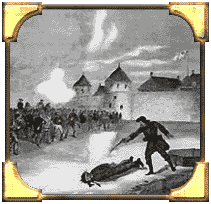|
1869: Timothy Eaton opens a dry-goods store the size of a 2-car garage on Yonge St. in 1869, creating the first of what will eventually become a nation-wide chain of department stores bearing his name. The Irish immigrant employs inventive sales strategies, revolutionizing the way Canadians do business. He introduces the "set price" concept to merchandising, eliminating the common practice of haggling. He institutes a guarantee of "goods satisfactory or money refunded," hoping to win the confidence of new consumers. Eaton directs his business at the swelling ranks of working men and women in Toronto who have money to spend. It works. Starting out with 3 clerks, an errand boy and Maggie the Wonder horse, who pulls delivery wagons, his annual sales rise from $25, 416 in l870 to $154, 985 in 1880.
 |
Eaton holds the first sidewalk sale in history, putting out bins of 5 cent ties and l cent spools of thread in front of the store. A strong Methodist, he won't sell playing cards or tobacco - thinking both are sinful. But he keeps adding to his roster of dry goods with other things; sporting goods, musical instruments, drugs, groceries. Eatons becomes a department store.
Eaton is also a pioneer of the Early Closing Movement, and by 1876 reduces the usual 12-hour working day. By 1904 the store closes at 5:00. By 1884 Eaton introduces his Mail Order Catalogue, uniting a whole country in its longing for goods. Out west they call it the "Prairie Bible."
Timothy Eaton leaves a succession of sons and grandsons to run his cross-country department store empire, but in 1999, the family declares bankruptcy, and a nation grieves the loss of a proud Canadian landmark.
1870: Thomas Scott is an angry, angular man, caught in the crossfire of a national crisis. He's also Orange Toronto's first martyr. Post Confederation Toronto is called the "Belfast of North America." It's an Irish Protestant town, and the Red River Rebellion in Manitoba hardens that identity. In 1870, Toronto sends 24 Kings Royal Rifles to Riel's Red River Rebellion. They can do nothing for Thomas Scott, a local Orangeman who is executed on the order of Riel. Anti-French and anti-Catholic rears its ugly face in Toronto again.
 |
After Scott´s execution, over 5000 indignant Torontonians gather at City Hall to listen to representatives from the Red River colony. They adopt a resolution supporting the colony and condemning the instigators of the Rebellion as murderers. Grisly, trumped up stories about Scott's torture feed the growing hatred. Rumours circulate about Scott being left half dead, screaming from a make-shift coffin hours after his supposed execution. In fact, Scott was led out into the Fort Garry courtyard, blindfolded with a white cloth and shot by 6 men with 2 or 3 bullets. When he lets out a ghastly groan, a man comes forward with a revolver and shoots him in the head. Dead.
But rumours persist and Orange fury percolates. Fifteen years will pass until Toronto can avenge Scott's martyrdom. When Riel's Northwest Rebellion fails in Saskatchewan in 1885, it is the threat of Orange Toronto's wrath that forces Prime Minister MacDonald's hand. Louis Riel must hang from a noose.
1881: Dr. Emily Stowe creates Canada's first suffragette group under the unassuming name of the Toronto Women's Literary Club. In 188l they come out in the open, asking for the vote. Three years later Toronto's single women are given the franchise. Married women or those without property will have to wait until 1918.
Emily Stowe spends her life breaking down barriers against women. She's Canada's first woman physician but has to practice illegally - women aren't allowed medical licenses in Canada. Dr. Stowe couldn't even get educated here; she had to study medicine in the US. Because the University of Toronto makes it so clear that women are not considered adequate to even apply for medical school, Stowe and her colleagues open Canada's first medical college for women. Soon after they open a dispensary and then a full fledge hospital, aptly named, Women's College Hospital.
1886: WH Howland stands as a candidate for the mayoralty of Toronto, supported on the shoulders of an informal Municipal Reform Association. Their strength is greater than they suspect, and Howland is elected by a majority of over 1900 votes.
From a well to do family, Howland courts the new women's vote on a ticket of morality, religion and reform. He is concerned with slum conditions, filthy streets, drunkenness and a foul water supply. He is Toronto's 25th mayor, the first one to base his campaign on the reform of the working class. He appoints a one-man Morality Squad, and continuing in an old Toronto institution, makes prostitution the all-consuming evil that good societies are rabidly opposed to.
1892: Henry Pellatt is the son of Toronto's first stock exchange president, and an ambitious young dandy with a "Midas touch." Famous today for his monumental legacy, Casa Loma, Pellatt earns the nickname "Pellatt the Plunger" as a speculator in western real estate and railway stocks. By 1892, Pellatt's Canadian Pacific Railway shares make him a millionaire 3 -4 times over.
Pellatt's good fortune rolls through the decades. He has holdings in both the Grand Trunk Pacific Railway and the CPR; is on the board of the Toronto Street Railway and the Home Bank of Canada. By 1910 he sits on boards of 100 companies, is chair or president of 17, and has a net worth of $17 million. $485 million today.
Ever peering into the distance for opportunities, Pellatt makes a new fortune in 1903, joining a powerful private syndicate to harness hydro electricity from nearby Niagara. He finagles a 30 year monopoly to provide street lighting for the city.
Continue
|
